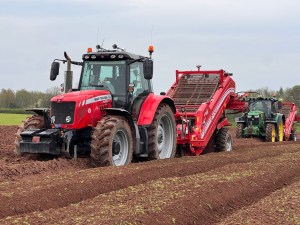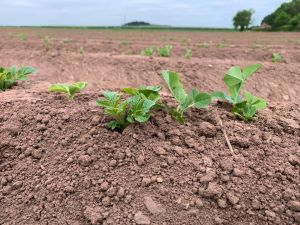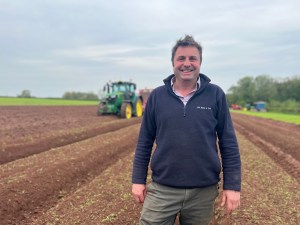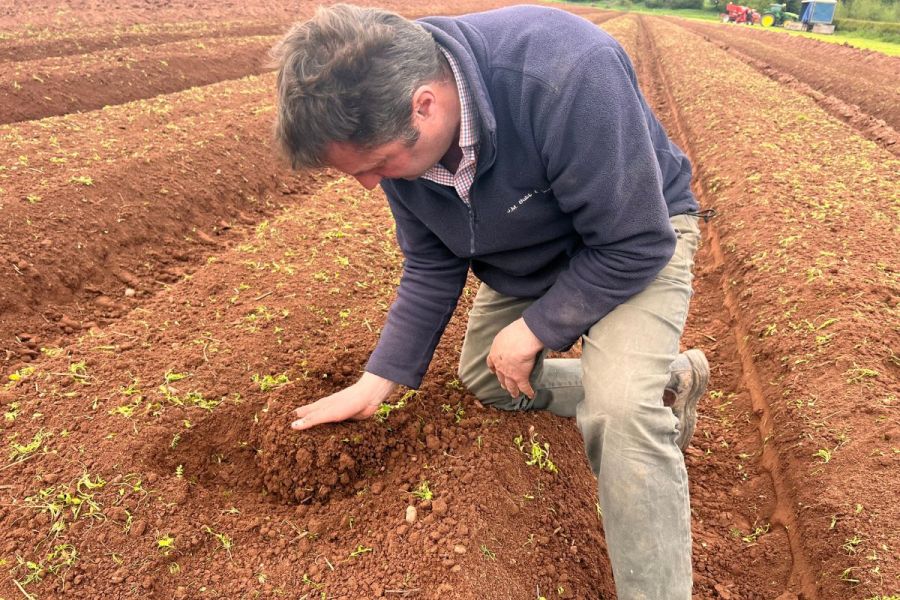Many battle with the concept of ‘regenerative’ potatoes and simply discount it for fear of risk. But small steps could pave the way for a more sustainable crop, as CPM investigates on one Shropshire farm.
“Many think you have to slam the door shut when it comes to potatoes in a regenerative system, but that’s simply not the case.”
By Emily Padfield
Change has never been something shied away from at Lynn South Farm. What started post-war as a typical Shropshire mixed farm of potatoes, sugar beet, cereals and dairy, has adapted through the generations and is now looking firmly to a more diverse, regenerative future.
The family-run farm currently consists of just over 800ha (2000acres) of rented and owned land, which currently grows a six-way rotation of potatoes (grown under contract for McCain), three winter feed wheats, oilseed rape, and flowers grown as part of the family’s hugely successful Shropshire Petals dried flower business.
“Almost 80% of the acreage is irrigated, lending itself to higher value crops, and our soils range from sand to sandy loams, with some heavier ground in places,” explains family member John Bubb, who is responsible for the arable and potato side of the business.
“Three years ago, our existing independent potato agronomist retired and we saw it as an opportunity to alter our system and explore more regenerative principles.”
As a result, John turning to Ed Brown, head of agroecology at Hutchinsons, to explore how potatoes could be grown in a more nature and soil-friendly manner as part of the rotation.
“Crucially, it’s the overall mindset that’s the important bit. And you have to make sure that everybody on the farm or in the team is on the same wavelength, working to achieve the same goal. At the time it was very easy to see the lack of worms, soils were seriously degraded, and we were in a downward cycle in terms of overall soil health,” says John.
Sugar beet formed part of the rotation until the local factory shut around 15 years ago. “We used to grow sugar beet and potatoes in a four-year rotation. So, for two years out of four we faced the very real threat of damaging soils should there be a wet autumn.”
The length of time between potatoes has increased steadily since the 1970s, he goes on to add. “The farm has gone from cropping potatoes one in three in the 1970s, through one in four in the 1980s and 1990s, one in five from 2005 to 2015, and now it’s one in six.
“Growing potatoes one year in six already marks a big shift in the right direction. Most of regenerative agriculture isn’t difficult, it’s logical,” believes John. “It’s effectively simpler than what we were previously doing, in some ways. It’s looking at the ‘how and why’ we do every step rather than applying a broad-brush approach and working with nature, not against it.”
John sees one of the biggest hurdles to the transition as the existing herbicide residue in the soil, as well as how the farm has been managed. “Our soils are used to high levels of ammonium nitrate as well as other inputs. We can all see and know the benefits for the future but it’s managing the risk and vulnerability in this transition period that’s the tricky bit. We, like all farmers, can’t risk not getting a saleable crop.”
In terms of applying these approaches on rented land, John believes it’s just as important as on his own ground. “For us to be good tenants going forward, we need to be seen to be doing things differently and hopefully adopting these principles will be a point of difference when it comes to renewing or being considered as tenants.”
Which is where some of the difficulty in regen can come from, he believes. “In an ideal world, we should be growing two acres of potatoes, two of carrots, two of everything else and running a load of livestock.
“That’s just not feasible for us or most commercial growers. That doesn’t mean we can’t at least try to integrate the principles where we can. We work closely with McCain and it’s a constant conversation with them about what ‘regenerative’ means.”
The processing company has made the bold statement that, by 2030, all potatoes sourced will come from farms that use regenerative practices. Alongside other growers, John is on a steering group with McCain to put together a schedule of what regenerative means and a way of measuring it as a company and on farm.
Spring established flower and potato crops provide ample opportunity for cover cropping, which was one of the first steps the farm took in order to improve soil structure and increase soil life, and these have formed part of the rotation for the past six years.
“The scary bit when using cover crops in potatoes is that, potentially, you’re feeding wireworm and subsequent nematodes throughout the winter months, whereas we used to overwinter with a clean stubble.
“Growers are understandably nervous of cover crops as if you have a whole crop affected, it’s a disaster. Touch wood, we haven’t seen any yet and my philosophy is of the bigger picture, we are hopefully encouraging the good nematodes, not just the bad.”
The cover crop of choice at Lynn South Farm is Hutchinsons’ MaxiVeg, which consists of linseed, buckwheat, phacelia, vetch and clover, plus oats. Sheep are grazed from January to mid-February, before the cover crop is terminated using glyphosate a couple of weeks ahead of planting, ideally in mid-March.
“It doesn’t always go to plan; this year has been hard work with 70% planted by the beginning of May.”

Instead of ploughing, a Simba DTX is used as a single-pass cultivator post-spraying. For the majority of ground, this is then followed by a bed former, destoner and finally planter.
One of the major changes to cultivation is the reduction in ploughing, which is now only used in exceptional circumstances. Instead of ploughing, a Simba DTX is used as a single-pass cultivator post-spraying. For the majority of ground this is then followed by a bed former, destoner and finally planter.
“Our main cultivation change is skipping bed tilling, when and where we can, thanks to soil structure improvements which I believe to be mostly down to cover cropping,” explains John.
“We still have to destone because we have a major potential problem, or at least we think we do,” he admits. “Obviously, if you have stones in the trailer at harvesting, you stand a risk of bruising the end product. It’s more about risk management as we just can’t afford to suffer that damage.
“We’re trying the odd acre here and there without destoning and there are a couple of local farmers that aren’t destoning at all, but it’s very much a case of soil type.”
Planting now takes place with a tine to reduce run-off and disturb the wheeling. Three varieties or potatoes were planted this year – Morene, Maris Piper and Royal.

In the future there might be an opportunity for re-ridging potatoes, planting into shallower soil and ridging up later. This would enable mechanical weeding and reduce reliance on herbicides.
“In the future there might be an opportunity for re-ridging potatoes. They do this this in the US, where you plant the potatoes shallower in warmer conditions and then ridge them up later.”
There are two advantages to this, he goes on to add. “One is that the plant gets to crop earlier, and secondly, it minimises risk of disease rather than sitting in cold, wet soil as the plant is up and growing quicker.
“An additional advantage of this method is that it lends itself to mechanical weed control, which could in turn reduce our reliance on herbicides. It’s only a theory though,” he’s quick to add.
“GPS technology is opening the doors to a lot of these mechanical options, allowing us to accurately carry out interrow cultivation with no fear of damaging the crop or making a mess.”
Harvesters are run on wide tyres or are self-propelled track machines and tractors, with trailers kept to a minimum during harvesting, where possible. “But again, we still have learning to do when it comes to harvesting at busy times into store, which needs thinking about,” adds John.
Other tools the farm has been making use of are SSM in-depth soil tests and regular SAP analysis. “SAP analysis is carried out every three weeks or so during the growing season on both potatoes and arable crops. With putting on less or at least reduced fertiliser, we’ve got to be careful there isn’t a yield penalty, so it’s a no brainer to measure it more accurately than we have in the past.”
The main benefit of SAP analysis is to get a true picture of the plant’s actual health, adds John. “We take a sample of the old and new leaf and send it to Novacrop, allowing us the chance to remedy things if levels aren’t correct. We’ve learnt a lot from it so far and now we’re not applying any phosphate, 15% less nitrogen and 30% less potassium.”
Seed dressings are now rarely used on potatoes and John is actively trying not to use any nematicides, falling back on Nemathorin (fosthiazate), if and when required. “This is helped by using new varieties that can resist and tolerate nematodes. I believe nematicides to be one of our worst enemies when it comes to soil and wider ecosystem damage.”

John Bubb says that most of regenerative agriculture isn’t difficult, it’s logical – looking at the ‘how and why’ rather than applying a broad-brush approach, working with nature, not against it.
Molasses and seaweed, alongside humic acid, is applied at planting with base fertiliser as well as foliar N during the growing season. Since going down the regenerative route, John is adamant that no ammonium nitrate is applied, only urea-based products.
“All other crops, bar potatoes, use controlled traffic farming systems and we’re adopting many of the same principles as we employ in potatoes, such as SAP analysis on the wheat and OSR, allowing us to reduce nitrogen, phosphate and potash applications overall.”
A Horizon strip-till cultivator and Horizon drill is used to establish both flowers and OSR. “One idea we’re looking at is a living clover mulch, strip tilled alongside crops for five years. The strip of clover would remain while either side of the strip could be wheat, flowers or OSR.
“Where we’re trying the living mulch, we’re drilling wheat with an older Weaving tine drill with two tines positioned close together, planting in a 15cm (six-inch) wide band rather than a row,” he explains.
“Getting the clover established has been our problem, but I believe it’s coming back to the residuals and the transition period. We’ve got to get a crop at the end of the day, so we’re still reliant on herbicides at the moment.”
A pioneering spirit runs in the genes of the Bubb family. In the mid-1980s, what started as small cottage garden business run by John’s Grandmother, supplying flowers to local WRI markets, started to grow into a crop in its own right. And by the 1990s, dried flowers made up 60ha of the rotation.
“By the end of the decade the popularity of Laura Ashley-inspired dried flowers waned, so my father and brother decided that, instead of keeping the petals on the stems, we could market the petals themselves as natural petal confetti. By 2014 the farm was growing over 45,000 flowers and they now make up 120ha of the rotation,” says John.
“Change is always challenging, doing the same thing is often easier and it can be hard work to do things differently when it’s what you’ve done for the past 50 years, but I strongly believe in what we are moving towards and so does our team.”
This article was taken from the latest issue of CPM. Read the article in full here.
For more articles like this, subscribe here.
Sign up for Crop Production Magazine’s FREE e-newsletter here.




